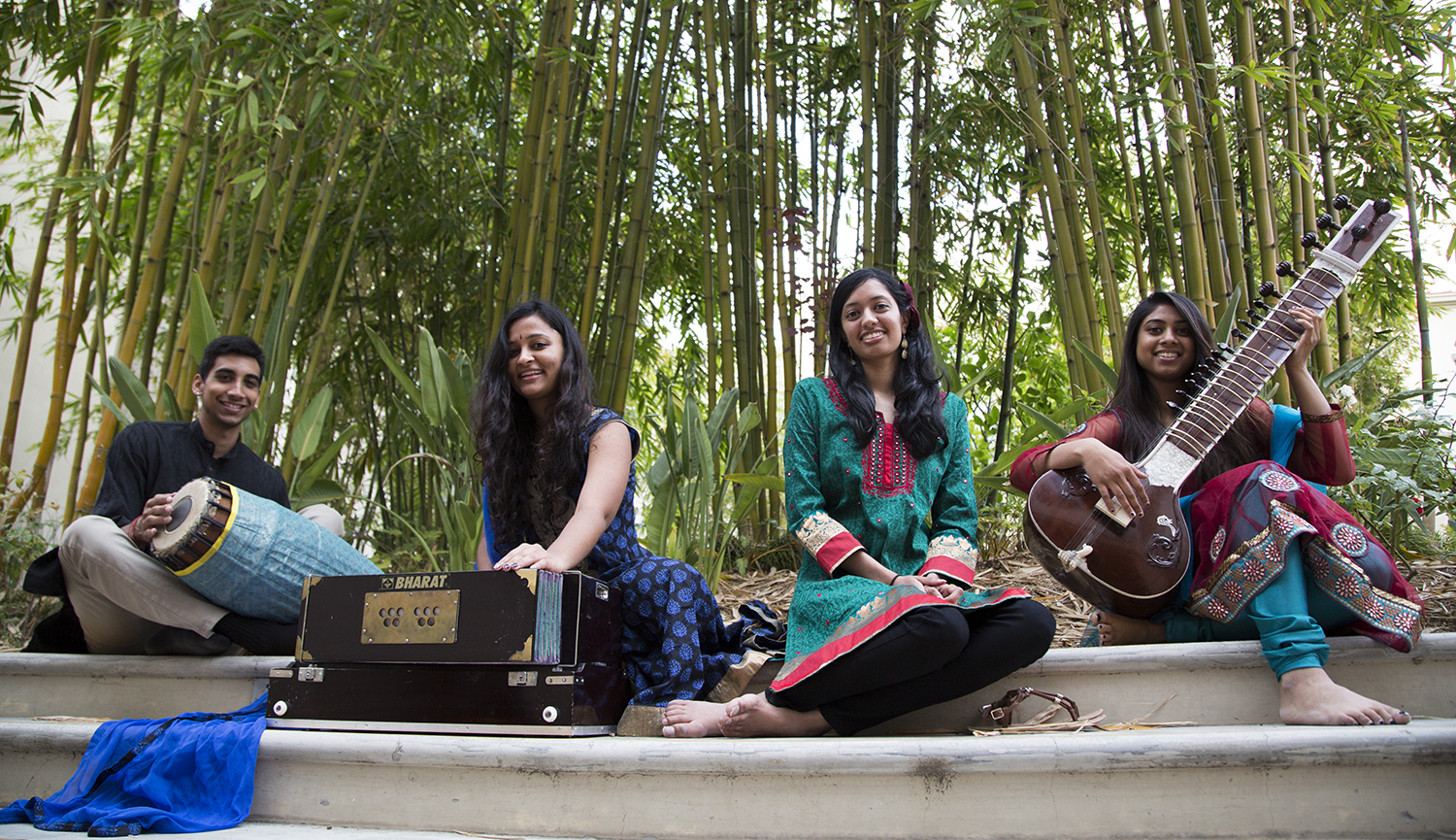Avartan Music Festival to bring together Indian classical performers

The fourth annual Avartan Music Festival will take place Sunday at Schoenberg Hall. Created in 2012 by UCLA alumna Gaayatri Kaundinya (center right), the festival is a showcase for Hindustani and Carnatic classical music, bringing together styles of North and South India. The group also includes fourth-year electrical engineering student Aditya Ganesh (far left), second-year psychology student Amulya Vadrevu (center left) and first-year psychobiology student Ritu Sreenivasan (far right). (Owen Emerson/Daily Bruin)
By Aalhad Patankar
May 8, 2015 2:19 a.m.
From center stage of Schoenberg Hall emanates a voice which holds a calming, single note, then glides through a musical scale before returning back.
The singer, UCLA alumna Gaayatri Kaundinya, sits cross-legged on the stage leading the performance. By her side sits her accompanist, who follows her every note with his violin only a split second after; and the percussionist, who upholds the rhythm by striking the tabla, a South Asian percussion instrument. The trio coordinates through an orchestrated precision; anything less and the performance falls apart.
But as the crowd listens, Kaundinya said, the three musicians listen even closer because, like the audience, they’ve never heard the piece before.
“In Indian classical music, the bulk of the performance is improvised,” Kaundinya said. “There is no sheet music, nothing is scripted beforehand.”
Kaundinya will take the stage again at the fourth annual Avartan Music Festival, a showcase for Hindustani and Carnatic classical music, on Sunday at Schoenberg Hall. Created by Kaundinya in 2012 and co-sponsored by the UCLA ethnomusicology department, the festival brings together young musicians from across the country to perform various styles of North and South Indian classical music.
The festival represents a larger cultural diaspora of Indian classical music through the migration of many of its trained teachers and practitioners to the United States, Kaundinya said.
Although the sound and nuance of the music carries centuries of South Asian tradition, Kaundinya said Avartan is unique in that it’s planned and executed by a younger generation of musicians born and raised outside of India.
“It’s a very young, vibrant atmosphere, different from playing a concert anywhere else,” said Vikas Yendluri, a Stanford alumnus and returning performer. “It’s a place where people of our group can preserve (the culture) and give it a modern touch.”
Second-year psychology student Amulya Vadrevu, volunteer coordinator and director of events for Avartan, said her favorite part of the festival is the performances, but not just the ones onstage.
“(Avartan) is like a massive jam session,” Vadrevu said. “Stepping backstage, they all have their instruments out, they’re all jamming, and the music is absolutely insane.”
Aside from the camaraderie, Kaundinya said this type of jam session allows the performers to get comfortable with each other musically because once they get on stage, coordination is key. Due to the high levels of improvisation, Kaundinya said, the performers on stage must work as a team to communicate through their music.
Sometimes, the conversation can be heard through the music. Occasionally, performers may engage in “sawaal jawaab,” an instrumental dialogue between the musicians in which one poses a question – sawaal – and another answers with his or her own phrase – jawaab.
These decisions are all made on stage, Kaundinya said, and thus require utmost concentration.
“It’s this very intense experience of creating and critiquing at the same time,” Kaundinya said. “All this has to happen in a split second, all in your mind.”
Underneath the layer of improvisation, however, lies a complex set of rules and a structure that take years to master, Kaundinya said. Indian classical music relies on a system of ragas, melodic modes of four or more notes that serve as foundational blocks for the music.
Kaundinya said that each raga carries not only its own rules of use, but also its own flavor. Under the structure of the raga, a musician can create and improvise a way of performing it that’s novel.
“Each raga has its own personality,” Kaundinya said. “For instance, bilawal is associated with joy and celebration. Sohini is a raga of love – many love songs are written in it – while marwa is a very intense raga, very angsty and associated with intense emotion.”
While the raga forms the basis of the performance, the festival took its name from another musical concept. The rhythmic composition of the music, called tala, is cyclical, and one full cycle is called an avartan.
“Our ancestors have developed this music for so long,” Kaundinya said. “We’ve moved away, but we’re bringing ourselves back full circle by doing this music so we can connect with them and our culture.”


